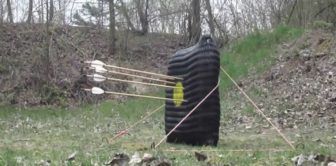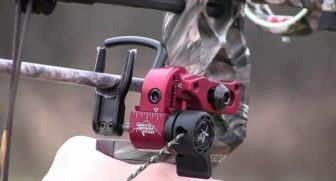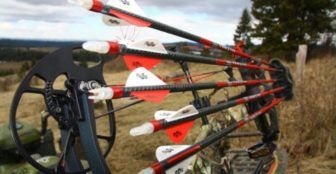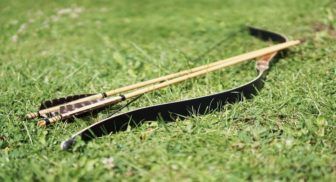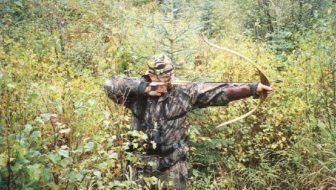How To Setup A Backyard Archery Range
Photo: northsidearcheryclub.org
When you decide to start archery as a hobby either in hunting or in competitive sport, you immediately realize that much practice is needed to improve your skill level.
While you can practice it at different facilities including a local archery shop or a dedicated club, these facilities may not always be available for use and might be expensive.
This article helps expound on how to set up a backyard archery range to make your practice easier and enjoyable!
Check Local Laws
Before setting up your recreational range, you will need to do due diligence on what is allowed or prohibited under the law. Some areas may not allow setting up an archery range for neighborhood safety reasons.
Check with your local governing authority or the police department to make sure you can set up one without legal contraventions.
Think about Safety Before You Build
While it may all be fun and games for you, archery can be a safety risk to other persons, their property, and even their pets. That is why you should consider the safety of your backyard archery range before you start its construction.
Some safety issues may include other activities that are likely to take place in the backyard for instance swimming or a play area to avoid accidents. You must also ensure that there will be no damage to equipment or property therein.
Some of the safety measures for you to consider include:
- Ensure there is a clear shooting line. It should be visible and straight on the ground. This line is where archers stand on or astride while shooting.
- The range must be set up in a way that the target is directly opposite the shooting position. This is because the archers are required to shoot in one direction, at right angles to the designated target.
- Anticipate how many people are going to be shooting at the range at any given time. This will help you decide how many shooting lanes to have because each archer is required to have their lane.
- Allow space for a backstop that will be placed behind the target.
- No activity is allowed behind the backstop. This means that you will not use the range if a swimming pool or a children’s play area is located there. Keep this in mind before setting up.
Layout and Measure Your Range
You can use a measuring tape or a measuring wheel, both of which are easily available in local home/ building supplies shops. Either will help you set up your range and measure the distance between the firing area and the target.
If you have a large backyard, you can easily manage a full-length archery range which is about 90 meters, which is the distance between the shooting line and the target. However, this is not always possible.
In that case, a half-range (45m) length will work just fine. It will allow you to polish your skills and you can do the full range practice elsewhere. Measure the distance to the target and get the halfway mark and some 10-meter increments for when you need to move the target without measuring every time.
The different mark points can be marked by digging into the ground and placing a marked brick there.
Ensure your layout is such that the sun will not shine directly on your face at any point in the day if possible. This is a factor in your comfort when shooting.
Mark the shooting line and make sure it is perpendicular or at a right angle to the target. The shooting line is permanent but depending on the shooting distance, the target can be moved closer or further.
If you anticipate sharing the range with others and space allows, you should consider having more shooting lanes parallel to each other and with their designated targets.
Build a Backstop
The backstop plays a major role in the safety of your archery range. It is usually located behind the target and plays the role of catching arrows that may miss the target, and those will be many especially for new archers.
Your backyard may already have a picket or privacy fence and although you may think of using it as a backstop, we advise against it. This is because the arrows may still go through it and cause accidents and secondly, the fence is inflexible and this may lead to arrow damage on impact.
Consider installing a flexible but strong backstop such as an archery netting which is made for the purpose. Other alternatives include old heavy carpets or heavy rubber mats which are easily available.
The backstop is supposed to be hung on a dedicated sturdy frame. Do not hang it on the fence to avoid damage to the arrows. You should also make sure it hangs all the way to the ground and you can consider adding weights to keep it low.
Round hay bales also act as excellent backstops. Arrange them in a way that no space is left between them and ensure they have sturdy back support. The bales are advantageous because there is limited noise on impact, unlike hard backstops. They also do not damage arrows.
All backstops must reach the ground level. The reasoning behind this is that there is a possibility of an archer missing a low shot because the targets are pretty low.
Get Some Targets for Your Range
Selecting Some Targets
There is a huge variety of targets to choose from depending on your needs on the range and of course, your budget. If you are into competitive archery, you will require a target face and target back, and hopefully, you can get the same face that you will fire at in the competitions.
Since you might be shooting at half range depending on the size of your backyard, you should consider using a half-sized target face and back. This allows you to practice your precision at the comfort of your home.
You will need to make or purchase target backing which catches and keeps the arrow in place to allow for score readings. There are target bags available for this purpose. However, you may prefer making your own using 1-2 round hay bales and cover them with AstroTurf for durability.
Other alternatives include using stacked carpet squares or foam floor squares tightly bound together by straps.
To save you from the trouble of making your target and its backing, you can purchase some that are ready-made. They even have the aiming points painted on them to save you all the trouble. The downside to these is that they tend to be more expensive than the foam ones. The advantage is that they are more durable and will serve you for more than 4 years.
For hunters with bigger ranges or for archers who participate in 3D archery tournaments, you should place 3D targets on your range. These targets are shaped like different animals and will give you good practice especially for suitable aiming points when you go hunting or competing.
How to Position the Target
This is an essential factor to consider. The target is supposed to be placed in front of the backstop and it should be perpendicular to the shooting line.
The placement distance is dependent on your preference and you can check the distance markers for the exact locations of placement. You will also need a stand on which to place the target to bring it up to your preferred height.
Place Distance Markers
There is a need to mark the distance on your range because that ensures the ease of moving the target around the range. This is necessitated by the fact that sometimes you may need to shoot at a closer range or long range.
You can dig a shallow line in the ground and place a store-bought marker at the end. Another option is placing a marked brick at the end of the line. Make sure the distance markers do not obstruct or become a stumbling point on the range by installing them correctly.
Add Other Equipment
Adding other equipment will ensure your range is more enjoyable and this effectively makes archery practice easier. You should therefore consider getting a bow stand or hooks just behind the firing line.
This allows you easy access to different bows during your practice. It also reduces the risk of stepping on a bow and damaging it while walking around the shooting line. You can buy a bow stand from your local archery shop or you can easily construct your own at home.
Install arrow holders at the firing line. This allows the arrows to be more accessible and thus you can manage rapid firing when you wish. Fancy holders are available in archery shops at you can opt to construct some using PVC pipes. Just cut them shorter than the arrows so that the fletching is not damaged.
Get more field point arrowheads and arrows of different weights. This allows you to get more practice for different scenarios. Additionally, you can get arrow pullers. There are worn on the palm to make pulling the arrows from the target much easier because you can easily exert more force on the arrow shaft.
Other accessories you can get include archery gloves and protective arm guards. These will allow you to have a wholesome practice and avoid bruises especially if you practice for long hours.
Make it Realistic
This is especially important for hunters because the scenarios on the hunting ground are not standardized, unlike in target shooting. Your target during hunting may be closer or farther than expected.
To enhance your skill, you could consider practicing shots at the target at different distances. In addition, you should practice shooting downhill, and to accomplish this, you will require a ladder or a platform at the shooting line. This will ensure you can shoot at an angle.
Another way to get your range to a more realistic level is by installing 3D targets because they allow you to practice realistic target points that would be beneficial in the field.
Read More: The Best Archery Target
Furthermore, you must ensure your backstop can handle broadhead arrowheads well. Give your backstop a much-needed upgrade if you realize the netting is easily torn by broadhead arrowheads. You can add some enhancement to it using rubber or a carpet.
This is because practicing with these hunting heads puts you in a position to feel the difference in the way they handle wind and interference. If you only use field points, you might be at a disadvantage when you go hunting.
Conclusion
Setting up a backyard archery range may sound cumbersome but a few pointers you need to observe include ensuring your local laws allow for such set-ups, adhering to safety measures, getting the range layout, and measuring distances around it.
You then set up a backstop and get a variety of targets, place distance markers then get more accessories or equipment for your range.
Depending on the intended end goal, you can consider making your range more fitted to hunting by installing 3D targets and having a platform to enable you to shoot at more realistic targets at an elevation or at an angle.
References
- A GuidetosettingupanArcheryRange - Archery GB

